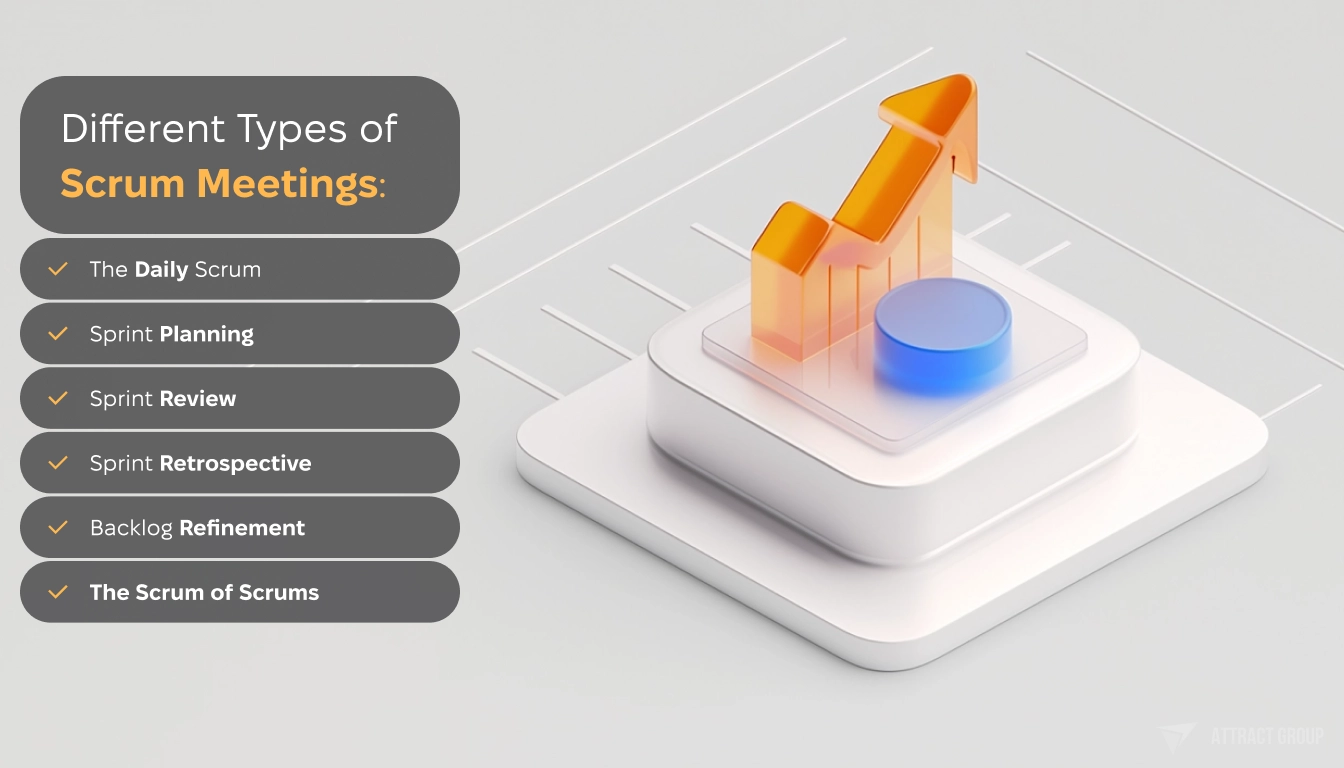Mastering Scrum Meetings: Types, Best Practices, and Outcomes
 14 December 2023
14 December 2023? Listen to the Summary of this article in Audio
In an Agile project environment, the vitality of Scrum meetings cannot be overstated. These gatherings act as the linchpin for teams employing the Scrum methodology, providing a structured platform for sharing critical information and ensuring that all team members are synchronized with the Sprint goals. Each type of Scrum meeting addresses a distinct phase of project development, contributing directly to the effectiveness and productivity of the team. To elevate this from routine checks to strategic success factors, one must understand and implement best practices, ensuring their outcomes drive team alignment and perpetuate the cycles of continuous improvement inherent to successful Agile projects.
A key to Scrum meeting mastery lies in their varied nature. Five specific meeting types – Sprint Planning, Daily Scrum, Sprint Review, Sprint Retrospective, and Backlog Refinement – guide the team from initial planning to reflective learning, each serving a unique and essential purpose. One should be aware that the power of these Scrum meetings is not in their mere existence but in their execution. Proper adherence to best practices, such as punctual starts, clear objectives, and no room for tardiness, can transform these agile rituals into dynamic forums that drive meaningful progress within the Scrum framework.
Key Takeaways
- Grasp the significance of different Scrum meeting types within Agile projects.
- Learn how adherence to Scrum meetings best practices elevates team productivity.
- Understand the role each Scrum meeting plays in aligning with Sprint goals.
- Acknowledge the importance of time management and clear objectives in this framework.
- Appreciate the need for conducting Scrum meetings that lead to effective outcomes.
- Recognize the continuous improvement cycle fostered by proper execution of Scrum methodology.
Introduction to Scrum and Its Significance in Agile Development
The advent of Agile methodology has ushered in a seismic shift in how software development is approached, emphasizing flexible strategies that can adeptly navigate through the mercurial landscape of technology. Within this methodology rests the Scrum framework, a subset designed to bolster collaboration in Agile environments. This approach focuses on iterative progress and the dynamic synergies fostered through regular Agile meetings, pivotal in charting the course of a project’s journey.
Scrum Masters and the Development Team, alongside the Product Owner, form the core collaboration axis within the Scrum paradigm. Their interactions through various structured Scrum ceremonies are critical for aligning team objectives, intensifying communication, and fostering an atmosphere of continuous evolution and improvement.
- The Sprint Planning kicks off the sprint, with the team coming together to decide on what work will be tackled.
- The Daily Scrum, a quick sync-up meeting, is critical to keep the momentum of the sprint and address any immediate impediments.
- As the sprint concludes, the Sprint Review opens a window for stakeholder feedback on the product increments.
- The sprint cycle is capped off with the Sprint Retrospective, a reflective practice session aiming to refine and elevate team processes.
These predefined touchpoints within the Scrum framework are not bureaucratic rituals but are instrumental in catalyzing productivity and efficacy across development initiatives. The profound value of Scrum meetings lies not only in the ritualistic gathering of team members but also in the consequent actions and adaptive strategies that emanate from these discussions. Ultimately, the Scrum framework, with its emphasis on teamwork and leadership through the roles of Scrum Masters and Product Owners, leverages the collective intelligence of the Development Team, driving agile projects toward successful completion with a robust, quality product.
Understanding the Different Types of Scrum Meetings
The landscape of Agile development is dotted with various types of Scrum meetings, each a cog in the machinery of project progression. Well-structured and purposefully executed Scrums are the hallmark of teams that thrive on the principles of iterative review and collaboration. Recognizing the role each meeting plays within the Scrum framework paves the way for heightened project success and synergy among team members.

The Daily Scrum: Purpose and Best Practices
The Daily Scrum is a cornerstone of team communication, lasting no more than 15 minutes, designed to synchronize the day’s work and highlight impediments. This meeting thrives on its fast pace and the clarity it brings to individual responsibilities, keeping the entire team aligned and agile.
Sprint Planning: Laying the Groundwork for Success
Just as a strong foundation is essential for any structure, Sprint Planning establishes the scope and trajectory of the sprint. In this meeting, the team engages with the product backlog to decide what can be achieved in the upcoming sprint, creating a well-defined Sprint Backlog that becomes the team’s to-do list.
Sprint Review: Evaluating Progress and Showcasing Work
As a Sprint draws to a close, the Sprint Review provides a platform to showcase the increment and gather feedback. It connects the Development Team with stakeholders, ensuring that the sprint’s results meet the business objectives and allow for adaptations if necessary.
Sprint Retrospective: Learning from the Past to Improve the Future
Much like a moment of reflection, the Sprint Retrospective is the team’s opportunity to appraise the just-concluded sprint, celebrating the wins and pinpointing areas for improvement. This meeting is about growth and optimization — integral features of the Scrum ethos.
Backlog Refinement: Prioritizing for Maximum Value
Engaging in the intricate process of Backlog Refinement means ensuring that items are clear, actionable, and estimated. By doing so, the team can enter Sprint Planning with a prioritized list that enhances productivity and value delivery.
The Scrum of Scrums: Coordinating Among Multiple Teams
When multiple teams are part of a larger ecosystem, the Scrum of Scrums becomes the platform for cross-team coordination. It is here that representatives from each team discuss progress, impediments, and dependencies, ensuring that all Scrums are moving forward in concert towards the project’s overarching goals.
| Meeting Type | Purpose | Participants | Frequency | Duration |
|---|---|---|---|---|
| Daily Scrum | Sync daily activities, highlight blockers | Development Team, Scrum Master | Daily | 15 minutes |
| Sprint Planning | Plan the Sprint’s work, create Sprint Backlog | Development Team, Scrum Master, Product Owner | At the start of the Sprint | 2-4 hours |
| Sprint Review | Assess progress, gather stakeholder feedback | Development Team, Scrum Master, Product Owner, Stakeholders | At the end of the Sprint | 1-2 hours |
| Sprint Retrospective | Reflect on the Sprint, identify improvements | Development Team, Scrum Master, Product Owner | At the end of the Sprint | 45-60 minutes |
| Backlog Refinement | Clarify and estimate Backlog items, prioritize | Development Team, Product Owner | Once per Sprint or as needed | 1-2 hours |
| Scrum of Scrums | Coordinate work between multiple teams | Scrum Master or Development Team representative(s) | Frequency as needed depending on project scale | 15-30 minutes |
Deep Dive into Scrum Meeting Best Practices
In pursuit of Agile excellence, the structure and execution of Scrum meetings are essential. Adhering to best practices ensures that these meetings are more than just a box-ticking exercise; they are dynamic sessions that advance the project goals. Effective Scrum meetings rely heavily on a symbiosis of meticulous preparation, punctuality, and meaningful participation, directly impacting the development team’s ability to maintain focus and momentum.
Striking at the heart of productivity, best practices equip teams to navigate the complexities of software development with agility and precision. Below, we delve into these practices, unraveling how each role within the Scrum team can optimize the value derived from these essential gatherings.
Facilitating Effective Communication in Scrum Meetings
Effective communication sets the stage for success. This involves not only conveying information succinctly but also nurturing an environment where open dialogue fosters problem-solving. Clear objectives, well-defined agendas, and nurturing a space for all voices encourage robust and relevant participation, pivotal to daily scrum best practices.
The Role of the Scrum Master in Enforcing Best Practices
The Scrum Master acts as the guardian of integrity. Upholding discipline — such as adherence to the scheduled start and end times of meetings — falls squarely within the Scrum Master’s remit. Embodying Scrum Master best practices, this role involves both facilitation and subtle orchestration to ensure that the meetings shine as an efficient beacon of progress.
Why the Product Owner’s Involvement Is Crucial
Aligning scrum practices with business objectives is an art in which the Product Owner plays a vital role. Their involvement in the meetings ensures that every discussion and every decision stays congruent with the product vision. Product owner involvement translates to a keener focus on delivering value to the client stakeholder and end-user.
Keeping Scrum Meetings Timeboxed and Efficient
To prevent derailment of Scrum meetings into the murky waters of protracted digressions, timeboxing is a critical practice. Limiting the length of the meetings promotes a culture of efficiency, preparing participants to discuss their points succinctly, and adhere closely to the agenda — hallmarks of optimal execution.
Engaging the Development Team: Questions and Participation
The true stars of Scrum — software developers — thrive when fully engaged in the process. Facilitating a two-way flow of information and encouraging developers to both ask and answer pointed questions bolsters development team engagement. Through such active involvement, every member becomes a custodian of the collective goal, driving the project forward with shared vigor.

- Establish a clear communication protocol for Scrum meetings.
- Emphasize the importance of the Scrum Master in maintaining meeting structure.
- Underline the pivotal contributions of the Product Owner in aligning discussions with business objectives.
- Adopt timeboxing as a nonnegotiable component of meeting management.
- Encourage the development team to partake actively through question-driven participation.
Comparing Different Scrum Meeting Types
Within the Scrum framework, the variety of meetings, each with its specific focus and participants, plays a crucial role in the success of Agile projects. It is essential to discern the purposes and particulars of these meetings to optimize them for the benefit of the development cycle. Here, we tackle some of the common mix-ups and clarify the distinctions between Scrum meetings to enhance their effective application.
Daily Standup vs. Daily Scrum: Clarifying the Confusion
Although ‘Daily Standup’ and ‘Daily Scrum’ are often used synonymously, they both refer to the same Scrum ritual — a quick conference to synchronize daily activities. The primary aim is to share progress and any blocking issues, keeping the development team on course. Ensuring everyone is on the same page with these brief, focused gatherings is essential to maintaining Agile momentum.
Sprint Retrospective: Attendees and Their Roles
The Sprint Retrospective is an intimate forum for the core team, where the focus is on self-improvement and process optimization. Key participants — the development team, Scrum Master, and Product Owner — reflect on the past Sprint to discover both successes and missteps. But it’s not just about identifying issues; it’s about committing to actionable solutions for continual growth.
Iteration Review vs. Retrospective: Understanding the Differences
Terminology in Agile can sometimes lead to confusion, particularly when discussing an Iteration Review vs. a Retrospective. While both occur at the end of a Sprint, the Iteration Review is outward-looking, focusing on the product with stakeholder involvement. In contrast, the Retrospective is inward-looking, aimed solely at improving the team’s processes and methods without stakeholder input.
Scrum Meeting vs. Stand Up: A Comparative Analysis
The term ‘Scrum Meeting’ might encompass various meeting types within the Scrum process, including the Daily Scrum, which is a Stand Up meeting. The distinction lies in the broader category of ‘Scrum Meetings’ as any meeting that supports the Scrum process, while ‘Stand Up’ specifically denotes the daily meeting focused on progress and immediate impediments.

| Meeting Type | Focus | Frequency |
|---|---|---|
| Daily Standup/Daily Scrum | Team progress and impediments | Daily |
| Sprint Retrospective | Reflecting on process improvements | End of Sprint |
| Iteration Review | Product demonstration and feedback | End of Sprint |
With this clarified understanding of the various meetings, teams can effectively leverage them to ensure alignment with Sprint goals, leading to a more streamlined development process and better product outcomes.
Our engineers deliver complex software projects on time using proven Scrum practices. Let us build your next web or mobile app leveraging iterative sprints.
How to Implement Scrum Meetings
For organizations looking to enhance their Agile processes, implementing Scrum meetings can be a game-changer. These meetings are crucial in fostering a highly responsive and cohesive development team adept at navigating complex project landscapes. The key is to approach implementation with a well-structured plan that incorporates an introduction to Scrum principles, comprehensive training, and evaluation methods for measuring their impact on the organization’s business outcomes.
Steps to Introducing Scrum Meetings
To set the stage for introducing Scrum meetings, begin with a comprehensive overview of the framework. Ensure that the entire team understands the purpose and the flow of the different Scrum ceremonies. Highlight the benefits of adopting Scrum, such as improved communication, clarity in responsibilities, and timely delivery of product increments. It is equally essential to prepare an environment that supports the Scrum ethos: transparency, inspection, and adaptation.
Training Your Team for Scrum Success
Equipping your team with the necessary tools and knowledge through Scrum training is vital to the successful integration of Scrum meetings into your development process. Focus on practical exercises that simulate real-world scenarios team members might encounter. A well-trained team should understand their role within the Scrum framework, feel confident in the process, and be proactive in their contributions to the meetings. Effective training leads to empowered teams that can self-organize and drive forward the vision of the project.
Measuring the Impact of Scrum Meetings on Your Business
In assessing the meeting impact, track qualitative and quantitative data that speaks to the productivity and efficiency of the team. Measure the alignment of meeting outcomes with sprint goals and the velocity with which the team completes tasks within the sprint. Observe how team dynamics and collaboration evolve over time, and identify areas where Scrum meetings can be fine-tuned for greater efficacy. Transparency in metrics and progress fosters a culture of trust and encourages ongoing improvement within the team.
With a dedication to rigorous implementation, regular training, and thorough impact analysis, Scrum meetings can contribute significantly to your organization’s agility and business success. The resulting alignment in team efforts and continual adaptation to project needs exemplify the robust nature of Agile development and underscore the value of these integral Agile ceremonies.
Troubleshooting Common Scrum Meeting Challenges
The efficacy of Scrum meetings can be hindered by a number of recurring issues. These challenges, such as overcoming Scrum resistance, increasing participation and engagement in Scrum, and managing Scrum time effectively, must be addressed proactively to ensure the productive flow of Agile processes in any organization. This section will explore strategies for resolving these common Scrum challenges, with a focus on fostering a more collaborative and time-conscious team environment.
Overcoming Resistance to Scrum Meetings
Resistance to adopting Scrum practices often stems from a lack of understanding of their strategic value. Clear communication regarding the benefits and purpose of Scrum meetings can demystify the process and encourage buy-in. Here’s a way to tackle this:
- Provide a clear explanation of Scrum benefits, focusing on improved productivity and quality of the end product.
- Involve team members in crafting meeting agendas to facilitate a sense of ownership.
- Share success stories where Scrum practices have led to tangible project improvements.
Solving Participation and Engagement Issues
Active participation in Scrum meetings is crucial, but not always a given. To combat this, it is imperative to create an environment that not only promotes but requires engagement from all team members. Here are strategies to increase participation:
- Implement a rotational system for meeting facilitation to involve each team member.
- Recognize and respect each voice during meetings, ensuring all opinions and insights are considered.
- Use creative techniques like interactive workshops to enliven Scrum discussions.

Addressing Time Management Difficulties in Scrum Meetings
Effective time management is a common struggle in Scrum meetings, yet it is critical for ensuring that the meetings do not become a drain on productivity. To keep Scrum meetings concise and focused, consider utilizing the following approaches:
- Strictly enforce the predetermined time-boxing of meetings, avoiding overrun.
- Prepare and distribute an agenda before the meeting to guide discussions.
- Train Scrum Masters to facilitate brisk, purpose-driven meetings that respect the team’s time.
By addressing the aforementioned challenges, teams can conduct more effective and engaging Scrum meetings. Although each organization may face unique hurdles in these areas, the general solutions provided can serve as a baseline template for improvement, contributing to the overarching aim of Scrum practice — which is to enhance the Agile development journey and ultimately lead to a more collaborative and productive team dynamic.
Scrum Meetings: The Path Forward for Modern Businesses
In the dynamic sphere of contemporary enterprise, Scrum meetings have emerged as a transformative force. As organizations navigate the complexities of modern business strategies and Agile development principles, the integration of Scrum into their operational fabric promises a future of enhanced innovation and streamlined processes. In an ecosystem where every iterative improvement can yield competitive advantages, the function of Scrum meetings is being redefined and optimized to drive team alignment with corporate agility and growth.
Case Studies: Scrum Meeting Success Stories
Real-world Scrum case studies illuminate the profound impact that optimized Scrum meetings have on project outcomes. For example, leading tech companies have demonstrated how these gatherings enable cross-functional teams to dissect complex problems, allowing for an incremental development approach that enhances customer satisfaction and accelerates product refinement. Through a systematic embrace of Scrum meeting principles, these firms have not only increased their operational efficiencies but have also carved out pioneering pathways in software development and product innovation.
The Future of Scrum Meetings in Agile Development
Looking ahead, the Scrum meetings future appears vibrant and omnipresent within Agile development cycles. As Scrum practices mature and businesses evolve, the potential for Scrum meetings to integrate with emerging technology and virtual collaboration tools is substantial. This evolution will likely enhance participation diversity, enrich data-driven decision-making, and offer new insights for optimizing Scrum meetings. The agility of Scrum accommodates upcoming trends, ensuring it remains integral in guiding teams through the labyrinth of an ever-changing business and technological landscape.
Final Thoughts on Optimizing Scrum Meetings for Your Team
A focal point for any team committed to Agile principles is the continuous optimization of Scrum meetings. Success in this arena hinges on a conscientious balance of adhering to core practices while also embracing flexibility and innovation. By remaining receptive to feedback, monitoring Scrum efficacy, and employing robust facilitation techniques, teams can hone their meetings to become precise instruments for operational excellence. Ultimately, Scrum meetings are not only about tracking progress — they are incubators for strategic thought, collective resolve, and the crystallization of goals into actionable realities.
Entrust your software initiative to our Scrum experts for efficient development and quality results. We offer end-to-end development services.
FAQ
What are Scrum meetings and why are they important in Agile development?
Scrum meetings are structured discussions that occur at specific times throughout a Sprint in Scrum, a subset of Agile methodology. They are essential for ensuring collaboration, adaptability, and iterative progress in project development by facilitating communication, aligning team objectives, and addressing challenges promptly.
Who typically participates in Scrum meetings?
Scrum meetings usually involve the Development Team, the Scrum Master, and the Product Owner. In some cases, stakeholders may also participate, especially during Sprint Reviews, to provide feedback on the product increment.
Can you outline the different types of Scrum meetings?
The primary types of Scrum meetings are the Daily Scrum (or Daily Standup), Sprint Planning, Sprint Review, Sprint Retrospective, and Backlog Refinement. Additionally, the Scrum of Scrums meeting may be held to coordinate between multiple Scrum teams working towards a common goal.
What are the best practices for conducting effective Scrum meetings?
Best practices include setting a clear objective and agenda, keeping meetings timeboxed and efficient, facilitating open and effective communication, and ensuring the full engagement and participation of the Development Team, Scrum Master, and Product Owner.
How do the Daily Scrum and Daily Standup meetings differ?
The Daily Scrum and Daily Standup are often considered synonymous and both are quick meetings for the team to sync on progress and impediments. However, Daily Standup is a more generic term used outside of Scrum contexts as well and does not necessarily follow the specific structure and rules set by the Scrum Guide.
Who should attend Sprint Retrospective meetings?
Sprint Retrospective meetings should be attended by the Development Team, the Scrum Master, and the Product Owner. The focus is on reflecting upon and improving the team process.
What are the key differences between Iteration Review and Sprint Retrospective?
The Iteration Review, also known as the Sprint Review, is focused on evaluating the product increment and obtaining stakeholder feedback, while the Sprint Retrospective is a meeting for the Scrum team to discuss the process and identify improvements for future sprints.
How does one implement Scrum meetings in an organization?
Implementing Scrum meetings involves introducing the Scrum framework’s principles and practices, training the team in Scrum, and consistently measuring the impact of these meetings on project progress and team collaboration.
How can resistance to Scrum meetings be overcome?
Overcoming resistance can be achieved by clearly communicating the benefits of Scrum meetings, involving the team in their execution, and ensuring each meeting delivers value by being well-structured and goal-oriented.
What are some strategies for addressing time management challenges in Scrum meetings?
Time management can be improved by strictly adhering to the timeboxed nature of Scrum meetings, keeping discussions focused on the agenda, and preventing meetings from veering off-topic.
How will Scrum meetings evolve with modern business strategies?
Scrum meetings will continue to adapt and refine in response to the changing business environment, incorporating feedback and remaining open to new methodologies that enhance collaboration and project efficiency within Agile contexts.










